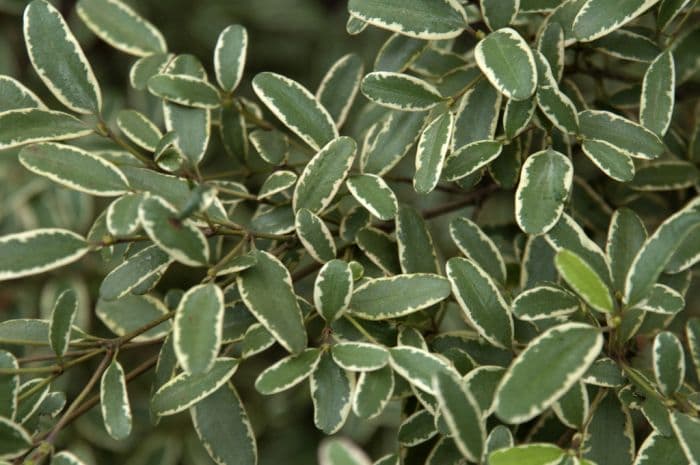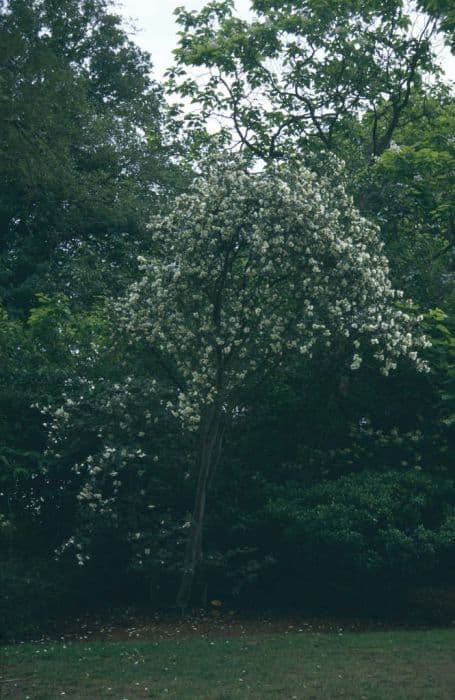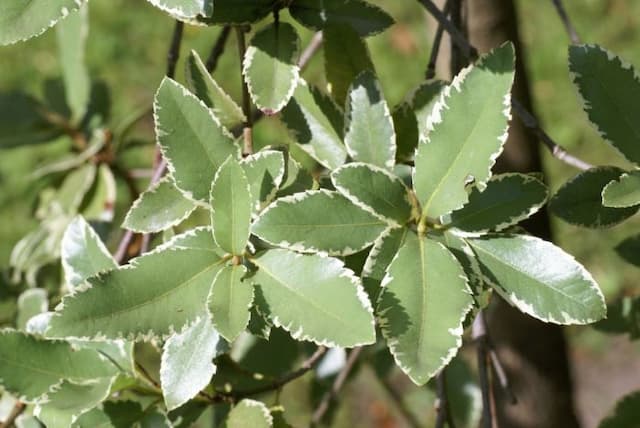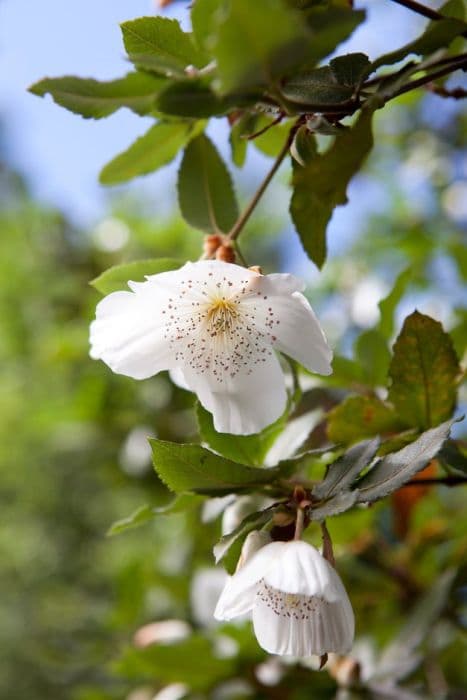Leatherwood Eucryphia lucida 'Spring Glow' (v)

ABOUT
Eucryphia lucida 'Spring Glow' is a beautiful ornamental plant known for its stunning floral display and attractive foliage. Its leaves are glossy and evergreen, providing a vibrant backdrop throughout the year. During the blooming season, this plant is adorned with an abundance of creamy-white flowers. The flowers are cup-shaped and feature a delicate arrangement of four petals surrounding a cluster of prominent yellow stamens, which add a touch of contrast and attract pollinators. The overall impression this plant gives is one of bright, refreshing elegance, with its flowers radiating a soft luminescence that seems to lighten up its surroundings. The leaves and flowers of this plant together create an eye-catching display that is both graceful and lively, making it a favored choice for gardens looking to add a splash of enduring color and charm.
About this plant
 Names
NamesFamily
Cunoniaceae
Synonyms
Tasmanian Leatherwood, Leatherwood
Common names
Eucryphia lucida 'Spring Glow' (v)
 Toxicity
ToxicityTo humans
Eucryphia lucida 'Spring Glow', commonly known as Leatherwood, does not have a well-documented profile of toxicity to humans. In most literature, there is no specific mention of this plant being hazardous when touched or ingested. However, as a general precaution with any plant material, it is advisable not to consume parts of plants unless they are known to be edible, as they may cause adverse reactions in some individuals. If a person suspects poisoning from any plant, they should seek medical attention.
To pets
Leatherwood or Eucryphia lucida 'Spring Glow' is not commonly listed as a toxic plant to pets. There is limited information available on its toxicity to animals like dogs and cats. Therefore, while there are no specific symptoms of poisoning associated with this plant in pets, as with human consumption, it's advisable to prevent pets from ingesting plants not known to be safe. If you notice any sign of illness in your pet after ingestion of any part of the plant, contact a veterinarian.
 Characteristics
CharacteristicsLife cycle
Perennials
Foliage type
Evergreen
Color of leaves
Green
Flower color
White
Height
12 feet (3.7 meters)
Spread
8 feet (2.4 meters)
Plant type
Tree
Hardiness zones
9
Native area
Tasmania
Benefits
 General Benefits
General Benefits- Ornamental appeal: Eucryphia lucida 'Spring Glow' (v), commonly known as Leatherwood, has striking white flowers that enhance the visual appeal of gardens and landscapes.
- Pollinator attraction: The blooms of the Leatherwood are known to attract bees and other pollinators, contributing to the health of local ecosystems.
- Seasonal interest: With its blossoming period in spring, Leatherwood adds seasonal interest to gardens when many other plants are not yet in flower.
- Habitat provision: This plant can provide shelter and nesting sites for various bird species, supporting biodiversity.
- Privacy screen: When planted in groups, Leatherwood can form a dense hedge, offering privacy and noise reduction for homeowners.
- Low maintenance: Leatherwood is known for being relatively low maintenance, requiring minimal pruning and care once established.
 Medical Properties
Medical PropertiesThis plant is not used for medical purposes.
 Air-purifying Qualities
Air-purifying QualitiesThis plant is not specifically known for air purifying qualities.
 Other Uses
Other Uses- Eucryphia lucida 'Spring Glow', commonly known as Leatherwood, can be used as a natural dye for fabrics, providing a range of colors depending on the mordant used.
- In woodturning, Leatherwood's timber is appreciated for its fine texture and is sometimes used to create ornate bowls or decorative items.
- Leatherwood is considered an excellent option for bonsai cultivation due to its small leaves and attractive flowers.
- The bark of the Leatherwood can be used in the craft of basket weaving, providing a unique texture and color to the finished product.
- As a nectar-rich plant, Leatherwood can be specifically grown to support apiculture, providing bees with a valuable source of food in the spring.
- The wood of Leatherwood is also used to make musical instruments like recorders or woodwind instruments due to its fine-grain and workability.
- In landscape photography, Leatherwood is sought after for its photogenic blossoms, which add aesthetic value to garden and nature scenes.
- Fallen Leatherwood flowers can be collected and used as a natural potpourri due to their pleasant fragrance.
- Essential oils extracted from Leatherwood flowers are sometimes used in aromatherapy as their scent is considered soothing and uplifting.
- Leatherwood leaves can serve as a natural additive to compost heaps, helping to balance the carbon-to-nitrogen ratio and enhance decomposition.
Interesting Facts
 Feng Shui
Feng ShuiThe plant Leatherwood is not used in Feng Shui practice.
 Zodiac Sign Compitability
Zodiac Sign CompitabilityThe plant Leatherwood is not used in astrology practice.
 Plant Symbolism
Plant Symbolism- Radiance: The 'Spring Glow' variety of the Tasmanian Leatherwood suggests a sense of luminosity and vitality, similar to the invigorating energy of spring.
- Purity: With its bright blooms, the Tasmanian Leatherwood is often associated with cleanliness and innocence.
- Endurance: Native to the rugged environments of Tasmania, the Tasmanian Leatherwood represents resilience and the ability to thrive despite challenges.
- Rare Beauty: As a less common ornamental plant, the Tasmanian Leatherwood may symbolize unique and understated elegance.
 Water
WaterThe Eucryphia, commonly known as 'Leatherwood', prefers consistent moisture and should be watered regularly, especially during its growing season in spring and summer. Water when the top inch of soil feels dry to the touch, approximately every seven to ten days, applying about 1 to 2 gallons of water for each watering depending on the size and age of the plant. During the fall and winter, reduce the frequency but do not let the soil completely dry out. Monitor the plant's response to watering and adjust accordingly, as overwatering can be just as detrimental as underwatering.
 Light
LightLeatherwood thrives best in a location that receives full sun to partial shade. The ideal spot would be where it can enjoy morning sunlight and some afternoon shade, particularly in hotter climates to prevent scorching. Ensure the plant is protected from intense midday sun which can damage the foliage and flowers.
 Temperature
TemperatureLeatherwood is hardy and can withstand a range of temperatures but thrives best in temperate climates. It prefers temperatures between 50°F and 70°F but can survive down to 20°F. However, extended exposure to temperatures below freezing can damage the plant. Ideal growing conditions include protection from harsh winter winds and excessively high summer temperatures.
 Pruning
PruningPruning Leatherwood helps maintain its shape, remove dead or diseased wood, and encourage healthy growth and flowering. The best time for pruning is after it has finished blooming in late spring or early summer. Typically, it is pruned annually or as needed to remove any wayward branches and to shape the plant.
 Cleaning
CleaningAs needed
 Soil
SoilLeatherwood 'Spring Glow' thrives best in well-draining, acidic to neutral soil with a pH of 5.5 to 7.0. The ideal soil mix should incorporate peat, pine bark, and perlite to ensure good drainage and aeration. Keep the soil moisture consistent without waterlogging.
 Repotting
RepottingLeatherwood 'Spring Glow' generally requires repotting every 2-3 years. It's best to repot in the spring before the growing season commences. Ensure the new pot is slightly larger to accommodate root growth.
 Humidity & Misting
Humidity & MistingLeatherwood 'Spring Glow' prefers moderate to high humidity levels. Keeping humidity around 50-60% will support its growth and maintain healthy foliage.
 Suitable locations
Suitable locationsIndoor
Ensure bright light, moderate humidity, and good air circulation.
Outdoor
Plant in partial shade, shelter from wind, well-draining soil.
Hardiness zone
7-9 USDA
 Life cycle
Life cycleEucryphia lucida 'Spring Glow', commonly known as Leatherwood, begins its life cycle with seed germination, which occurs when conditions of moisture and temperature are suitable. The seedlings establish themselves and progressively develop into juvenile plants, forming a small shrub with characteristic leaves. As the Leatherwood matures, it enters the vegetative growth stage, producing more foliage and increasing in both height and girth. Upon reaching maturity, which can take several years, the Leatherwood begins its reproductive phase, flowering in late summer with white, often fragrant blossoms that attract pollinators. After pollination, seeds are produced and disseminated, either by wind or wildlife, to begin the next generation of plants. The Leatherwood continues to grow and can live for many years, flowering annually, and gradually reaching its full size, completing its life cycle when it eventually ages and dies.
 Propogation
PropogationPropogation time
Early Spring
The Leatherwood 'Spring Glow' is typically propagated through semi-hardwood cuttings. This involves taking a cutting of about 4 to 6 inches (10 to 15 centimeters) from the current year’s growth during the late summer or early autumn. The bottom leaves of the cutting are removed, and the cut end is often treated with a rooting hormone to encourage root development. Then, the cutting is placed in a well-draining potting medium and kept moist under high humidity conditions, such as in a cold frame or under a plastic cover to maintain the moisture levels. The cuttings will usually root within a few weeks to months depending on environmental conditions.




